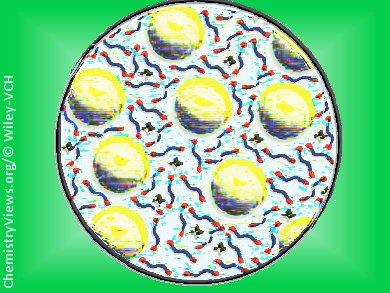Room temperature ionic liquids (RTILs) have been touted as non-volatile, non-flammable alternatives to organic solvents. A wide range of properties in such materials are available, but chemists at the Chinese Academy of Sciences have now found a way to blend two otherwise immiscible ionic liquids to form a nanoemulsion. A nanoemulsion comprises a thermodynamically unstable colloid of two liquids in which one is suspended in the other as nanoscopic droplets (pictured). This makes them potentially useful as novel media for preparative reactions.
The team stirred together the hydrophilic propylammonium formate and hydrophobic 3-methyl-1-octylimidazolium hexafluorophosphate ionic liquids together with the surfactant sodium bis(2-ethylhexyl) sulfosuccinate to form a nanoemulsion. They then tested the utility of such a concoction in the preparation of nanorods of the metal-organic framework (MOF) compound La-BTC-MOF. They were able to make mesoporous nanorods that are larger than those synthesized in conventional solvents.
- Ionic Liquid-in-Ionic Liquid Nanoemulsions,
Jianshen Li, Jianling Zhang, Buxing Han, Li Peng, Guanying Yang,
Chem. Commun. 2012.
DOI: 10.1039/C2CC36089F




